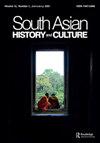‘No one heard me!’: sexual self-fashioning and the child in ‘Lihāf’
IF 0.3
0 ASIAN STUDIES
引用次数: 0
Abstract
ABSTRACT ‘Lihāf’ by Ismat Chughtai is widely read as a tale of feminist and queer rebellion but it also narrates a complex account of a young girl’s initiation into sexuality as a result of her molestation by a much older woman. In this narratological study that also draws upon the historical context of the Urdu world of letters which framed Chughtai’s own self-fashioning as a writer and intellectual, I argue that the case for a feminist and queer-positive reading of ‘Lihāf’ often misses or downplays the sexual molestation of the narrator as a child and remains inattentive to the ways in which Chughtai constructs conflict and tension between the two voices that narrate the story: that of the adult narrator, a Muslim woman, who opens the tale and then, deploying the voice and perspective of a child, recalls and reconstructs the memory of the fateful events of her childhood. Central to my reading is the point of view of the child whose movement in and through the female-dominated zenānā re-presents the case for viewing ‘a women’s utopia’ in dystopic ways. By splitting the female perspective into two overlapping realms – those of the adult and the child – Chughtai rewrites desire as experienced by the ‘New Woman,’ a historical figure of feminist emancipation often identified in established literary and critical readings with Begum Jān. Such an identification, I argue, is, in fact, unidimensional and is trenchantly undermined in the story by the brutal and intersecting logic of patriarchal domination and class exploitation, a logic at whose fulcrum is the figure of the child as the dark Other of the New Woman.“没人听到我说话!”:性自我塑造与《Lihāf》中的儿童
Ismat Chughtai的摘要《Lihāf》被广泛解读为一个女权主义和酷儿反叛的故事,但它也讲述了一个复杂的故事,讲述了一名年轻女孩因被一名年长得多的女性猥亵而开始性生活。在这项叙事学研究中,也借鉴了乌尔都语字母世界的历史背景,这一背景构成了楚泰作为作家和知识分子的自我塑造,我认为,对《Lihāf》进行女权主义和酷儿积极解读的理由往往忽略或淡化了叙述者小时候的性骚扰,并且仍然忽视了Chughtai在讲述故事的两个声音之间构建冲突和紧张的方式:成年叙述者,一个穆斯林女性,她打开了故事,运用孩子的声音和视角,回忆和重建她童年的重大事件。我阅读的核心是孩子的观点,她在女性主导的禅宗中的运动为以反乌托邦的方式看待“女性乌托邦”提供了理由。通过将女性视角分为两个重叠的领域——成人和儿童——Chughtai改写了“新女性”所经历的欲望,“新女性是女权主义解放的历史人物,在与Begum Jān的既定文学和评论读物中经常被提及。事实上,我认为,这种认同是单向的,在故事中被父权统治和阶级剥削的残酷而交叉的逻辑所严重破坏,这种逻辑的支点是孩子作为新女性的黑暗他者的形象。
本文章由计算机程序翻译,如有差异,请以英文原文为准。
求助全文
约1分钟内获得全文
求助全文

 求助内容:
求助内容: 应助结果提醒方式:
应助结果提醒方式:


